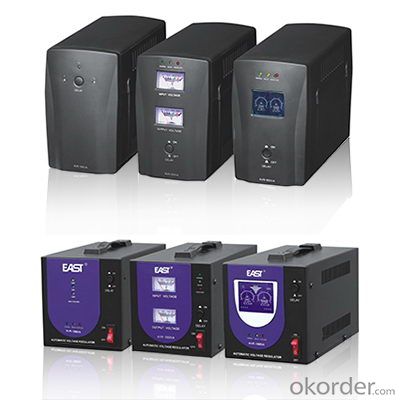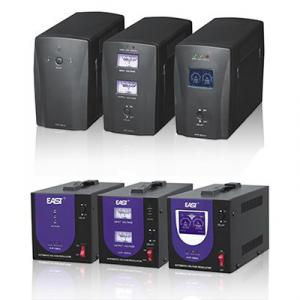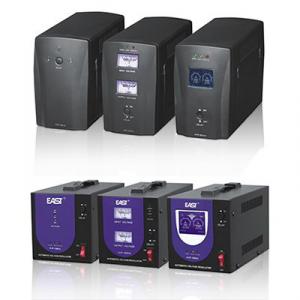Solar Power Inverter AVR 500-5000VA 2015 Very Popular CE Excellent Quality Approved
- Loading Port:
- China main port
- Payment Terms:
- TT or LC
- Min Order Qty:
- 1 pc
- Supply Capability:
- 1000 pc/month
OKorder Service Pledge
OKorder Financial Service
You Might Also Like
| AVR 500-5000VA |
AVR series AC automatic regulators apply the advanced control technology with well qualified components It has the features of wide input voltage compatibility, high reliability, output voltage stabilizing, energy saving ect....; it has over voltage and low voltage protection and delayed output protection ect.. it could supply stabilized power to lights, TVs, air-conditioners, refrigerator, computers and duplicating machines and other household equipment in schools, offices, hotels, meeting rooms where the stabilized voltage is needed. |
● Classic series, EI transformer, relay type
● Input and output voltage LED/Meter/LCD display
● High temperature protection
● Circuit breaker protection
● Efficiency: 98%

MODEL | 500VA | 800VA | 1000VA | 1500VA | 2000VA | 3000VA | 5000VA | |
Input | ||||||||
Phase | Single Phase+N+GND | |||||||
Voltage Range | 140Vac-270Vac (Option:100-270V) | |||||||
Output | ||||||||
Voltage Range | 200-240V(Empty Load) | |||||||
Frequency | 50/60Hz | |||||||
Over Voltage Protection | 250V±5V (Overvoltage indicator on, Output off ) | |||||||
Undervoltage Protection | 180V±5V (Overvoltage indicator on, Output off ) | |||||||
Others | ||||||||
Efficiency | ≥95% | |||||||
Display Mode | LED indicator light; Pointer voltmeter / LCD display (selectable) | |||||||
Input/Output Setting | Plug/ Socket | Terminal blocks | ||||||
Time-Delay | Short delay : <3 secs; long delay: 3mins | |||||||
Output Short Circuit Protection | Fuse / Breaker | |||||||
Waveform Distortion | No additional waveform distortion | |||||||
Insulation Resistance | >2MΩ | |||||||
Dielectric Strength | Low frequency sine voltage 1500V for 1 minute ( without phenomena of breakdown and flashover ) | |||||||
Ambient Temperature | -10℃~±40℃ | |||||||
Relative Humidity | ≤95% | |||||||
Working | Continuing Working | |||||||
Dimension(W×D×H) mm | Metal Case | 125×230×135 | 143×258×185 | 210x291x201 | 229x345x220 | |||
Plastic Case | 100×215×160 | —— | ||||||
Net Weight (kg) | Metal Case | 2.5 | 2.9 | 3.1 | 5.4 | 6.5 | 9.2 | 13.0 |
Plastic Case | 2.1 | 2.5 | 2.7 | —— | ||||
Packing Dimension (W×D×H) mm | Metal Case | 176×280×207 | 192×310×252 | 262x343x273 | 271x396x303 | |||
Plastic Case | 145×265×229 | —— | ||||||
Gross Weight(kg) | Metal Case | 2.8 | 3.2 | 3.4 | 5.6 | 6.7 | 9.6 | 13.55 |
Plastic Case | 2.4 | 2.8 | 3.0 | —— | ||||
Quantity/20ft | 2400PCS | 1600PCS | 900PCS | 730PCS | ||||
· Q. What is an UPS and What it is for ?
An uninterruptible power supply (UPS) is a device that allows your computer or telephone switch or critical equipement to keep running for at least a short time or longer time when the primary power source is lost. It also provides protection from power surges, spikes, brownouts, interference and other unwanted problems on the supported equipment.
· Q. How long the UPS to run when power goes?
This can take 3 paths.
1.You can pick a UPS that is rated for pretty much the full VA you need so it will be running at 100% of capability and will thus last 'n' minutes.
2.You can pick a UPS that is rated at a much higher VA value than you really need so, for example, is running at 50% of capability and will thus last for longer than the UPS from option 1.
3.You can use extra external battery packs to run for longer. If charging capability allows, the more and the bigger batteries you take with, the longer time UPS runs.
or using a generator after about 6 hours, it will be more cost-effective, with a short runtime UPS to bridge the generator start-up gap.
- Q:Can a solar inverter be used with a solar-powered remote monitoring system?
- Yes, a solar inverter can be used with a solar-powered remote monitoring system. The solar inverter converts the DC (direct current) electricity generated by the solar panels into AC (alternating current) electricity that can be used to power the remote monitoring system. This allows the system to be powered by solar energy and provides the necessary electricity for monitoring and data transmission.
- Q:How much maintenance is required for a solar inverter?
- Solar inverters typically require minimal maintenance. Most modern inverters are designed to be reliable and durable, requiring little to no maintenance throughout their lifespan. However, occasional cleaning of the inverter's vents and ensuring proper ventilation can help optimize its performance. Additionally, monitoring the inverter's performance and checking for any error messages or unusual behavior can help identify and address any potential issues. Overall, the maintenance required for a solar inverter is generally minimal, making it a low-maintenance component of a solar system.
- Q:What is the role of a solar inverter in maximizing solar panel output?
- The role of a solar inverter in maximizing solar panel output is to convert the direct current (DC) electricity generated by the solar panels into alternating current (AC) electricity that can be used in our homes and businesses. Additionally, the inverter ensures that the solar panels operate at their maximum power point, optimizing their efficiency and output. It also monitors and controls the flow of electricity, ensuring safety and preventing any damage to the solar panels or the electrical system.
- Q:How does a solar inverter protect against voltage fluctuations?
- A solar inverter protects against voltage fluctuations by continuously monitoring the voltage levels from the solar panels. It adjusts the voltage to match the grid voltage, ensuring a stable and consistent flow of electricity. Additionally, it employs various protective mechanisms such as overvoltage or undervoltage protection, surge protection, and fault detection to safeguard the system from voltage fluctuations and potential damage.
- Q:How does a solar inverter handle grid voltage variations?
- A solar inverter handles grid voltage variations by constantly monitoring the grid voltage and adjusting its output accordingly. It uses complex algorithms to regulate the voltage and frequency of the electricity it feeds into the grid, ensuring it matches the varying grid voltage. This allows the solar inverter to maintain a stable and consistent power output, regardless of any fluctuations in the grid voltage.
- Q:How is the output voltage and frequency of a solar inverter regulated?
- The output voltage and frequency of a solar inverter are regulated through a combination of control algorithms and power electronics. These control algorithms constantly monitor and adjust the voltage and frequency based on the energy generated by the solar panels and the power requirements of the connected load. The power electronics, such as voltage regulators and frequency converters, ensure that the output voltage and frequency remain within the desired range. This regulation is crucial to provide stable and consistent power to the electrical grid or the connected devices.
- Q:What is the role of a solar inverter in preventing system downtime?
- The role of a solar inverter in preventing system downtime is to convert the direct current (DC) produced by solar panels into alternating current (AC) that can be used to power electrical devices and to feed excess energy back into the grid. By maintaining a stable and reliable flow of electricity, solar inverters help prevent disruptions and downtime in the solar energy system, ensuring continuous operation and maximizing energy efficiency.
- Q:How does MPPT technology work in solar inverters?
- MPPT technology, or Maximum Power Point Tracking, is utilized in solar inverters to optimize the energy output of photovoltaic systems. It works by continuously tracking the maximum power point of the solar panel array, which is the voltage and current combination that allows the panels to generate the maximum power. The MPPT algorithm adjusts the operating voltage and current of the solar panels to match the optimal point, ensuring that the maximum amount of power is extracted from the solar array and converted efficiently by the inverter. By constantly adapting to changing environmental conditions, MPPT technology maximizes the solar energy harvest, improving system efficiency and overall performance.
- Q:What are the key differences between a central inverter and a string inverter?
- The key differences between a central inverter and a string inverter lie in their design and functionality. A central inverter is a large, centralized unit that converts the DC electricity generated by a solar array into AC electricity. It is typically installed in a central location, such as a utility room, and is responsible for converting the power from multiple strings of panels simultaneously. On the other hand, a string inverter is a smaller unit that is installed close to the solar panels and converts the DC power from each individual string into AC power. One major difference is the level of scalability. Central inverters are typically used in larger solar installations, such as commercial or utility-scale projects, where a large number of panels are connected in parallel. They can handle high power capacities and are highly efficient. In contrast, string inverters are commonly used in smaller residential or small-scale commercial installations, where a smaller number of panels are connected in series. They offer flexibility in system design and can be easily expanded or modified. Another difference is the impact of shading or module mismatch. In a string inverter system, if one panel in a string is shaded or experiences reduced performance, it can affect the overall output of the entire string. This is because all panels in a string are connected in series, and the output is limited by the weakest performing panel. In a central inverter system, however, the impact of shading or module mismatch is minimized as each string operates independently, allowing for better performance optimization. Additionally, maintenance and monitoring differ between the two types. Central inverters are easier to access and maintain as they are typically installed in a dedicated location. They also offer advanced monitoring capabilities, allowing for centralized tracking of system performance. String inverters, being installed close to the panels, require more individual maintenance and monitoring efforts. Both central and string inverters have their own advantages and disadvantages, and the choice between them depends on factors such as project size, system design, shading conditions, and budget.
- Q:How do you choose the right size solar inverter for a specific solar power system?
- To ensure optimal performance and efficiency of your solar power system, careful consideration of various factors is necessary when selecting the appropriate size solar inverter. Follow these steps to make the right choice: 1. Calculate your solar power system's total capacity: Begin by determining the combined wattage of all your solar panels. This information can typically be found in the product specifications or obtained from your solar panel manufacturer. 2. Evaluate your average energy consumption: Assess your typical energy consumption to determine the size of the solar inverter required to meet your needs. Take into account peak power usage and potential future increases in energy demands. 3. Match the inverter's capacity with your system's: Ensure that the solar inverter's capacity is equal to or slightly higher than your system's total capacity to achieve optimal performance. 4. Consider the inverter's efficiency: Seek out an inverter with high efficiency ratings. A higher efficiency rating means it can convert a larger percentage of solar energy into usable electricity, minimizing power losses. 5. Select the appropriate inverter type: Decide which type of solar inverter is suitable for your system. The three main types are string inverters, microinverters, and power optimizers. String inverters are the most common and cost-effective choice for small to medium-sized systems, while microinverters and power optimizers are better suited for complex installations or systems with shading issues. 6. Assess additional features: Take into account any additional features offered by the solar inverter. Look for features like monitoring capabilities, grid integration capabilities, and built-in safety features such as arc fault protection or rapid shutdown. 7. Seek professional advice: If you are uncertain about selecting the right size solar inverter for your specific solar power system, consulting a professional solar installer or electrical engineer is advisable. They can help assess your energy needs, system requirements, and provide expert guidance in choosing the appropriate inverter size. Remember, making an informed decision when choosing the right size solar inverter is crucial for your system's overall performance and efficiency. Take the time to evaluate your system's requirements and seek expert advice to ensure the best outcome.
1. Manufacturer Overview |
|
|---|---|
| Location | |
| Year Established | |
| Annual Output Value | |
| Main Markets | |
| Company Certifications | |
2. Manufacturer Certificates |
|
|---|---|
| a) Certification Name | |
| Range | |
| Reference | |
| Validity Period | |
3. Manufacturer Capability |
|
|---|---|
| a)Trade Capacity | |
| Nearest Port | |
| Export Percentage | |
| No.of Employees in Trade Department | |
| Language Spoken: | |
| b)Factory Information | |
| Factory Size: | |
| No. of Production Lines | |
| Contract Manufacturing | |
| Product Price Range | |
Send your message to us
Solar Power Inverter AVR 500-5000VA 2015 Very Popular CE Excellent Quality Approved
- Loading Port:
- China main port
- Payment Terms:
- TT or LC
- Min Order Qty:
- 1 pc
- Supply Capability:
- 1000 pc/month
OKorder Service Pledge
OKorder Financial Service
Similar products
New products
Hot products
Hot Searches
Related keywords































